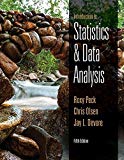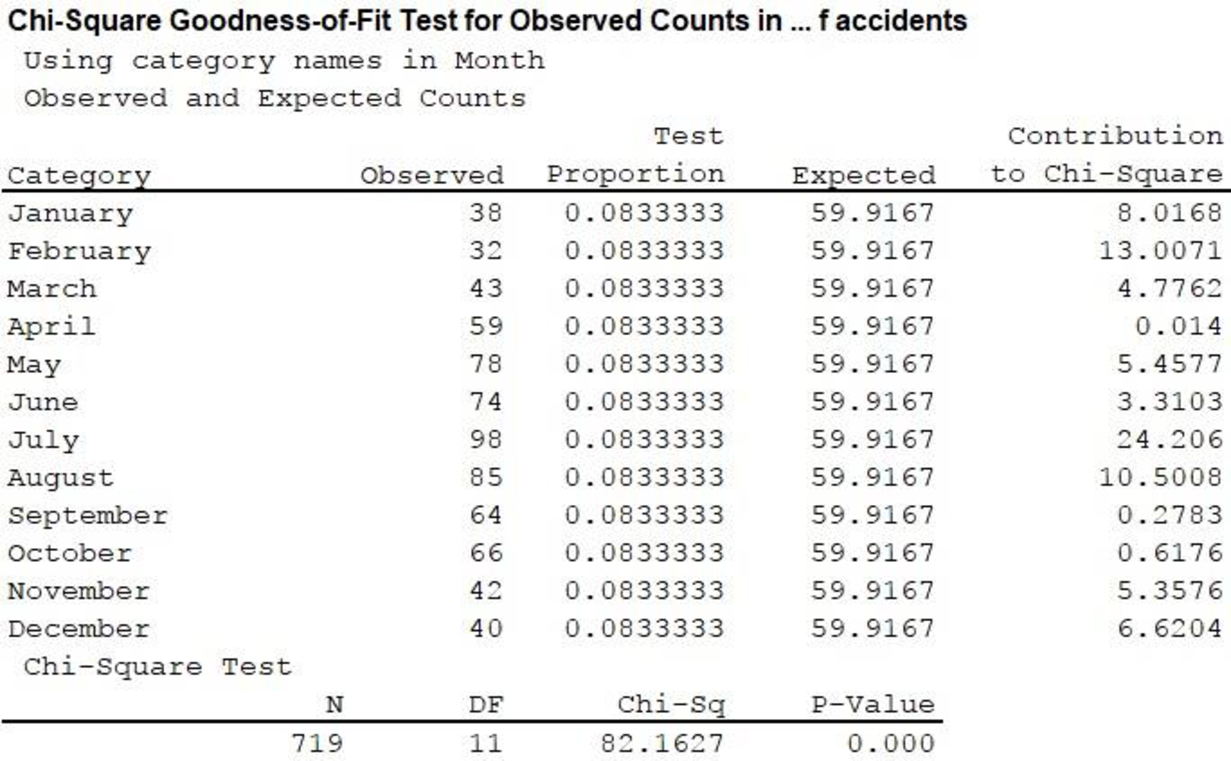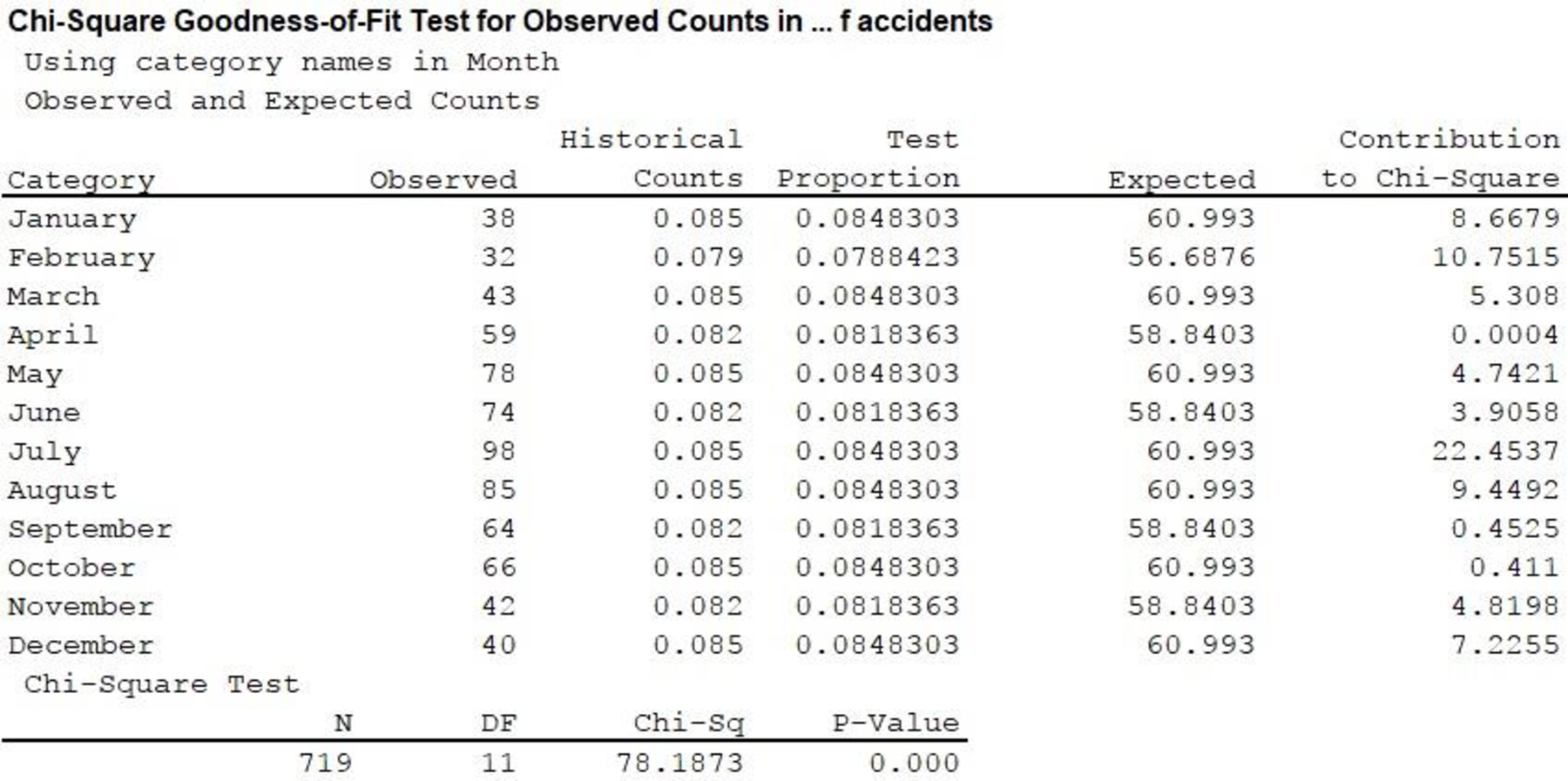
a.
Test whether fatal bicycle accidents are equally likely to occur in each of the 12-months at 0.01 significance level.
a.
Answer to Problem 10E
There is convincing evidence that fatal bicycle accidents are not equally likely to occur in each of the months.
Explanation of Solution
Calculation:
The given data represent the classification of fatal bicycle accidents according to the month in which the accident occurred.
The expected counts are calculated as shown below:
| Month | Observed counts | Expected counts |
| January | 38 | |
| February | 32 | |
| March | 43 | |
| April | 59 | |
| May | 78 | |
| June | 74 | |
| July | 98 | |
| August | 85 | |
| September | 64 | |
| October | 66 | |
| November | 42 | |
| December | 40 | |
| 719 | 719 |
The nine-step hypotheses testing procedure to test goodness-of-fit is given below:
1. Consider that the proportion of fatal bicycle accidents occurring in January is
2. Null hypothesis:
3. Alternative hypothesis:
4. Significance level:
5. Test statistic:
6. Assumptions:
- Assume that the 719 accidents included in the study is a random sample from the population of fatal bicycle accidents.
- From the table, it is observed that all the expected counts are greater than 5.
7. Calculation:
Software procedure:
Step-by-step procedure to obtain the test statistics and P-value using the MINITAB software:
- Choose Stat > Tables > Chi-Square Goodness-of-Fit Test (One Variable).
- In Observed counts, enter the column of Number of Accidents.
- In Category names, enter the column of Month.
- Under Test, select the Equal Proportions.
- Click OK.
The output obtained using the MINITAB software is given below:

From the output,
8. P-value:
From the MINITAB output,
9. Conclusion:
Decision rule:
- If P-value is less than or equal to the level of significance, reject the null hypothesis.
- Otherwise, do not reject the null hypothesis.
Conclusion:
Here the level of significance is 0.01.
Here, P-value is less than the level of significance.
That is,
Hence, reject the null hypothesis. Therefore, there is convincing evidence that fatal bicycle accidents are not equally likely to occur in each of the months.
b.
Write the null and alternative hypotheses to determine if some months are riskier than others by taking differing month lengths into account.
b.
Explanation of Solution
The null hypothesis in Part (a) specifies that fatal accidents are equally likely to occur in any of the 12 months.
The year considered in the study is 2004, which is a leap year. It is known that a leap year contains 366 days, with 29 days in February.
The null and alternative hypotheses to determine if some months are riskier than others by taking differing month lengths and the characteristics of a leap year into account are as follows:
Null hypothesis:
Alternative hypothesis:
c.
Test the hypotheses proposed in Part (b) at 0.05 significance level.
c.
Answer to Problem 10E
There is convincing evidence that fatal bicycle accidents do not occur in any of the twelve months in proportion to the lengths of the months.
Explanation of Solution
Calculation:
The expected counts are calculated as shown below:
| Month | Observed counts |
Proportion | Expected counts |
| January | 38 | 0.085 | |
| February | 32 | 0.079 | |
| March | 43 | 0.085 | |
| April | 59 | 0.082 | |
| May | 78 | 0.085 | |
| June | 74 | 0.082 | |
| July | 98 | 0.085 | |
| August | 85 | 0.085 | |
| September | 64 | 0.082 | |
| October | 66 | 0.085 | |
| November | 42 | 0.082 | |
| December | 40 | 0.085 | |
| 719 | 1 (approximately) | 719 |
Significance level:
Test statistic:
Assumptions:
- Assume that the 719 accidents included in the study is a random sample from the population of fatal bicycle accidents.
- From the table, it is observed that all the expected counts are greater than 5.
Calculation:
Software procedure:
Step-by-step procedure to obtain the test statistic and P-value using the MINITAB software:
- Choose Stat > Tables > Chi-Square Goodness-of-Fit Test (One Variable).
- In Observed counts, enter the column of Number of Accidents.
- In Category names, enter the column of Month.
- Under Test, select the column of Proportion in Proportions specified by historical counts.
- Click OK.
The output obtained using the MINITAB software is given below:

From the output,
8. P-value:
From the MINITAB output,
9. Conclusion:
Decision rule:
- If P-value is less than or equal to the level of significance, reject the null hypothesis.
- Otherwise, do not reject the null hypothesis.
Conclusion:
Here the level of significance is 0.05.
Here, P-value is less than the level of significance.
That is,
Hence, reject the null hypothesis.
Therefore, there is convincing evidence that fatal bicycle accidents do not occur in any of the twelve months in proportion to the lengths of the months.
Want to see more full solutions like this?
Chapter 12 Solutions
Bundle: Introduction to Statistics and Data Analysis, 5th + WebAssign Printed Access Card: Peck/Olsen/Devore. 5th Edition, Single-Term
- 1. A consumer group claims that the mean annual consumption of cheddar cheese by a person in the United States is at most 10.3 pounds. A random sample of 100 people in the United States has a mean annual cheddar cheese consumption of 9.9 pounds. Assume the population standard deviation is 2.1 pounds. At a = 0.05, can you reject the claim? (Adapted from U.S. Department of Agriculture) State the hypotheses: Calculate the test statistic: Calculate the P-value: Conclusion (reject or fail to reject Ho): 2. The CEO of a manufacturing facility claims that the mean workday of the company's assembly line employees is less than 8.5 hours. A random sample of 25 of the company's assembly line employees has a mean workday of 8.2 hours. Assume the population standard deviation is 0.5 hour and the population is normally distributed. At a = 0.01, test the CEO's claim. State the hypotheses: Calculate the test statistic: Calculate the P-value: Conclusion (reject or fail to reject Ho): Statisticsarrow_forward21. find the mean. and variance of the following: Ⓒ x(t) = Ut +V, and V indepriv. s.t U.VN NL0, 63). X(t) = t² + Ut +V, U and V incepires have N (0,8) Ut ①xt = e UNN (0162) ~ X+ = UCOSTE, UNNL0, 62) SU, Oct ⑤Xt= 7 where U. Vindp.rus +> ½ have NL, 62). ⑥Xn = ΣY, 41, 42, 43, ... Yn vandom sample K=1 Text with mean zen and variance 6arrow_forwardA psychology researcher conducted a Chi-Square Test of Independence to examine whether there is a relationship between college students’ year in school (Freshman, Sophomore, Junior, Senior) and their preferred coping strategy for academic stress (Problem-Focused, Emotion-Focused, Avoidance). The test yielded the following result: image.png Interpret the results of this analysis. In your response, clearly explain: Whether the result is statistically significant and why. What this means about the relationship between year in school and coping strategy. What the researcher should conclude based on these findings.arrow_forward
- A school counselor is conducting a research study to examine whether there is a relationship between the number of times teenagers report vaping per week and their academic performance, measured by GPA. The counselor collects data from a sample of high school students. Write the null and alternative hypotheses for this study. Clearly state your hypotheses in terms of the correlation between vaping frequency and academic performance. EditViewInsertFormatToolsTable 12pt Paragrapharrow_forwardA smallish urn contains 25 small plastic bunnies – 7 of which are pink and 18 of which are white. 10 bunnies are drawn from the urn at random with replacement, and X is the number of pink bunnies that are drawn. (a) P(X = 5) ≈ (b) P(X<6) ≈ The Whoville small urn contains 100 marbles – 60 blue and 40 orange. The Grinch sneaks in one night and grabs a simple random sample (without replacement) of 15 marbles. (a) The probability that the Grinch gets exactly 6 blue marbles is [ Select ] ["≈ 0.054", "≈ 0.043", "≈ 0.061"] . (b) The probability that the Grinch gets at least 7 blue marbles is [ Select ] ["≈ 0.922", "≈ 0.905", "≈ 0.893"] . (c) The probability that the Grinch gets between 8 and 12 blue marbles (inclusive) is [ Select ] ["≈ 0.801", "≈ 0.760", "≈ 0.786"] . The Whoville small urn contains 100 marbles – 60 blue and 40 orange. The Grinch sneaks in one night and grabs a simple random sample (without replacement) of 15 marbles. (a)…arrow_forwardSuppose an experiment was conducted to compare the mileage(km) per litre obtained by competing brands of petrol I,II,III. Three new Mazda, three new Toyota and three new Nissan cars were available for experimentation. During the experiment the cars would operate under same conditions in order to eliminate the effect of external variables on the distance travelled per litre on the assigned brand of petrol. The data is given as below: Brands of Petrol Mazda Toyota Nissan I 10.6 12.0 11.0 II 9.0 15.0 12.0 III 12.0 17.4 13.0 (a) Test at the 5% level of significance whether there are signi cant differences among the brands of fuels and also among the cars. [10] (b) Compute the standard error for comparing any two fuel brands means. Hence compare, at the 5% level of significance, each of fuel brands II, and III with the standard fuel brand I. [10] �arrow_forward
- Analyze the residuals of a linear regression model and select the best response. yes, the residual plot does not show a curve no, the residual plot shows a curve yes, the residual plot shows a curve no, the residual plot does not show a curve I answered, "No, the residual plot shows a curve." (and this was incorrect). I am not sure why I keep getting these wrong when the answer seems obvious. Please help me understand what the yes and no references in the answer.arrow_forwarda. Find the value of A.b. Find pX(x) and py(y).c. Find pX|y(x|y) and py|X(y|x)d. Are x and y independent? Why or why not?arrow_forwardAnalyze the residuals of a linear regression model and select the best response.Criteria is simple evaluation of possible indications of an exponential model vs. linear model) no, the residual plot does not show a curve yes, the residual plot does not show a curve yes, the residual plot shows a curve no, the residual plot shows a curve I selected: yes, the residual plot shows a curve and it is INCORRECT. Can u help me understand why?arrow_forward
 Glencoe Algebra 1, Student Edition, 9780079039897...AlgebraISBN:9780079039897Author:CarterPublisher:McGraw Hill
Glencoe Algebra 1, Student Edition, 9780079039897...AlgebraISBN:9780079039897Author:CarterPublisher:McGraw Hill Holt Mcdougal Larson Pre-algebra: Student Edition...AlgebraISBN:9780547587776Author:HOLT MCDOUGALPublisher:HOLT MCDOUGAL
Holt Mcdougal Larson Pre-algebra: Student Edition...AlgebraISBN:9780547587776Author:HOLT MCDOUGALPublisher:HOLT MCDOUGAL

